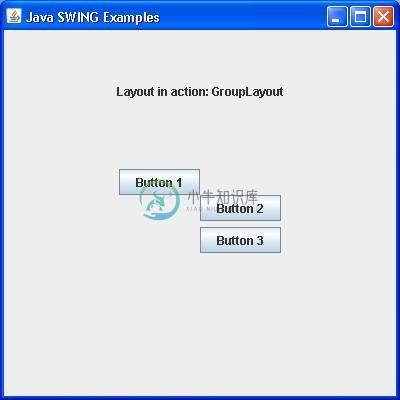GroupLayout
介绍 (Introduction)
GroupLayout类对组件进行分层分组,以便将它们放置在Container中。
Class 声明 (Class Declaration)
以下是javax.swing.GroupLayout类的声明 -
public class GroupLayout
extends Object
implements LayoutManager2
字段 (Field)
以下是javax.swing.GroupLayout类的字段 -
static int DEFAULT_SIZE - 指示组件或间隙的大小应用于特定范围值。
static int PREFERRED_SIZE - 表示组件的首选大小或间隙应用于特定范围值。
类构造函数 (Class Constructors)
| Sr.No. | 构造函数和描述 |
|---|---|
| 1 | GroupLayout(Container host) 为指定的Container创建GroupLayout。 |
Class Methods
| Sr.No. | 方法和描述 |
|---|---|
| 1 | void addLayoutComponent(Component component, Object constraints) 已将组件添加到父容器的通知。 |
| 2 | void addLayoutComponent(String name, Component component) 已将组件添加到父容器的通知。 |
| 3 | GroupLayout.ParallelGroup createBaselineGroup(boolean resizable, boolean anchorBaselineToTop) 创建并返回一个ParallelGroup,它沿着基线对齐它的元素。 |
| 4 | GroupLayout.ParallelGroup createParallelGroup() 创建并返回一个Alignment.LEADING对齐的ParallelGroup。 |
| 5 | GroupLayout.ParallelGroup createParallelGroup(GroupLayout.Alignment alignment) 创建并返回具有指定对齐方式的ParallelGroup。 |
| 6 | GroupLayout.ParallelGroup createParallelGroup(GroupLayout.Alignment alignment, boolean resizable) 创建并返回具有指定对齐和调整大小行为的ParallelGroup。 |
| 7 | GroupLayout.SequentialGroup createSequentialGroup() 创建并返回SequentialGroup。 |
| 8 | boolean getAutoCreateContainerGaps() 如果自动创建容器与边框容器之间的间隙,则返回true。 |
| 9 | boolean getAutoCreateGaps() 如果自动创建组件之间的间隙,则返回true。 |
| 10 | boolean getHonorsVisibility() 返回在调整和定位组件时是否考虑组件可见性。 |
| 11 | float getLayoutAlignmentX(Container parent) 返回沿x轴的对齐方式。 |
| 12 | float getLayoutAlignmentY(Container parent) 返回沿y轴的对齐方式。 |
| 13 | LayoutStyle getLayoutStyle() 返回用于计算组件之间的首选间隙的LayoutStyle。 |
| 14 | void invalidateLayout(Container parent) 使布局无效,表明如果布局管理器缓存了信息,则应将其丢弃。 |
| 15 | void layoutContainer(Container parent) 布置指定的容器。 |
| 16 | void linkSize(Component... components) 强制指定的组件具有相同的大小,无论其首选大小,最小大小或最大大小如何。 |
| 17 | void linkSize(int axis, Component... components) 强制指定的组件沿指定的轴具有相同的大小,而不管它们的首选,最小或最大大小。 |
| 18 | Dimension maximumLayoutSize(Container parent) 返回指定容器的最大大小。 |
| 19 | Dimension minimumLayoutSize(Container parent) 返回指定容器的最小大小。 |
| 20 | Dimension preferredLayoutSize(Container parent) 返回指定容器的首选大小。 |
| 21 | void removeLayoutComponent(Component component) 通知已从父容器中删除组件。 |
| 22 | void replace(Component existingComponent, Component newComponent) 用新的组件替换现有组件。 |
| 23 | void setAutoCreateContainerGaps(boolean autoCreateContainerPadding) 设置是否应自动创建容器与触摸容器边框的组件之间的间隙。 |
| 24 | void setAutoCreateGaps(boolean autoCreatePadding) 设置是否应自动创建组件之间的间隙。 |
| 25 | void setHonorsVisibility(boolean honorsVisibility) 设置在调整和定位组件时是否考虑组件可见性。 |
| 26 | void setHonorsVisibility(Component component, Boolean honorsVisibility) 设置是否考虑组件的可见性以确定大小和位置。 |
| 27 | void setHorizontalGroup(GroupLayout.Group group) 设置用于沿横轴定位和调整组件的组。 |
| 28 | void setLayoutStyle(LayoutStyle layoutStyle) 设置用于计算组件之间首选间隙的LayoutStyle。 |
| 29 | void setVerticalGroup(GroupLayout.Group group) 设置沿垂直轴定位和调整组件大小的组。 |
| 30 | String toString() 返回此GroupLayout的字符串表示形式。 |
方法继承 (Methods Inherited)
该类继承以下类中的方法 -
- java.lang.Object
GroupLayout示例
使用您选择的任何编辑器创建以下Java程序,例如D:/ 》 SWING 》 com 》 xnip 》 gui 》
SwingLayoutDemo.java
package cn.xnip.gui;
import java.awt.*;
import java.awt.event.*;
import javax.swing.*;
public class SwingLayoutDemo {
private JFrame mainFrame;
private JLabel headerLabel;
private JLabel statusLabel;
private JPanel controlPanel;
private JLabel msglabel;
public SwingLayoutDemo(){
prepareGUI();
}
public static void main(String[] args){
SwingLayoutDemo swingLayoutDemo = new SwingLayoutDemo();
swingLayoutDemo.showGroupLayoutDemo();
}
private void prepareGUI(){
mainFrame = new JFrame("Java SWING Examples");
mainFrame.setSize(400,400);
mainFrame.setLayout(new GridLayout(3, 1));
headerLabel = new JLabel("",JLabel.CENTER );
statusLabel = new JLabel("",JLabel.CENTER);
statusLabel.setSize(350,100);
mainFrame.addWindowListener(new WindowAdapter() {
public void windowClosing(WindowEvent windowEvent){
System.exit(0);
}
});
controlPanel = new JPanel();
controlPanel.setLayout(new FlowLayout());
mainFrame.add(headerLabel);
mainFrame.add(controlPanel);
mainFrame.add(statusLabel);
mainFrame.setVisible(true);
}
private void showGroupLayoutDemo(){
headerLabel.setText("Layout in action: GroupLayout");
JPanel panel = new JPanel();
// panel.setBackground(Color.darkGray);
panel.setSize(200,200);
GroupLayout layout = new GroupLayout(panel);
layout.setAutoCreateGaps(true);
layout.setAutoCreateContainerGaps(true);
JButton btn1 = new JButton("Button 1");
JButton btn2 = new JButton("Button 2");
JButton btn3 = new JButton("Button 3");
layout.setHorizontalGroup(layout.createSequentialGroup()
.addComponent(btn1)
.addGroup(layout.createSequentialGroup()
.addGroup(layout.createParallelGroup(
GroupLayout.Alignment.LEADING)
.addComponent(btn2)
.addComponent(btn3))));
layout.setVerticalGroup(layout.createSequentialGroup()
.addComponent(btn1)
.addComponent(btn2)
.addComponent(btn3));
panel.setLayout(layout);
controlPanel.add(panel);
mainFrame.setVisible(true);
}
}
使用命令提示符编译程序。 转到D:/ 》 SWING并键入以下命令。
D:\SWING>javac com\xnip\gui\SwingLayoutDemo.java
如果没有错误发生,则表示编译成功。 使用以下命令运行该程序。
D:\SWING>java cn.xnip.gui.SwingLayoutDemo
验证以下输出。


